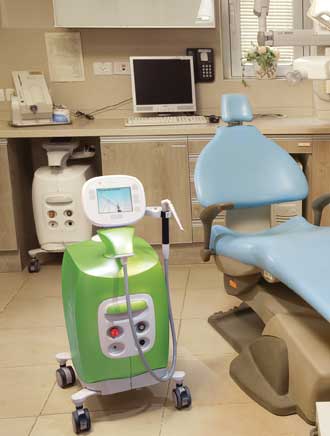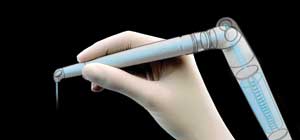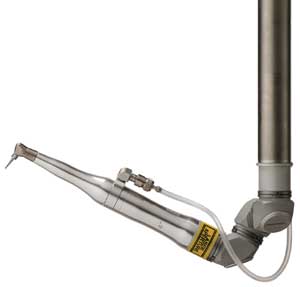Lasers offer dentists distinct advantages in diagnosis and surgery, and laser companies expect the market to continue to grow.
The laser once may have been a solution in search of a problem, but today it is ubiquitous in a wide range of applications: There are lasers in your entertainment technologies, in your communications systems, in your cars and, increasingly, in your mouth.
Dentists today can use lasers for both surgical and diagnostic procedures, and researchers are looking to expand uses for lasers in dentistry. To gauge the market for dental lasers, BioPhotonics spoke with two leaders in the industry: Ira Prigat, president and CEO of Syneron Dental Lasers in Yokneam, northern Israel, and Grant Womack, director of clinical services and research and development at Deka Lasers in Carlsbad, Calif.

The LiteTouch nonfiber Er:YAG dental laser system from Syneron Dental Lasers was designed for both hard and soft dental tissues.
For both hard and soft dental tissues, Syneron Dental Lasers makes the LiteTouch nonfiber Er:YAG dental laser system, which incorporates the laser into the handpiece to imitate a turbine drill. Deka Lasers makes CO2, Er:YAG, Nd:YAG and 980-nm diode lasers for various dental applications.
Q: What do you see as the “next big thing” in laser-based dentistry in general?
Womack: Minimally invasive surgical protocols utilizing laser technology. Technology that is an improvement in speed and efficiency – and, most of all, patient healing and comfort vs. traditional blade surgery.
Prigat: It is clear that the dental industry has started advocating lasers, as an increasing number of scholars have been involved in research activities that prove the efficacy of lasers in a wide range of dental procedures. Furthermore, a growing number of universities have already adopted special laser education programs in their curricula, thus sending a clear message that lasers are the future.

Laser-in-the-Handpiece technology from Syneron Dental Lasers
incorporates the laser directly into the workpiece to imitate a turbine
drill.
More solid proof of this has recently emerged as we learned that the organizers of the most influential global event in dentistry, the biannual International Dental Show, will be featuring dental laser technology as its major theme during its next meeting in 2013.
Q: Are you seeing any new and exciting advances coming out of R&D and/or university labs?
Womack: Biostimulation causing cellular differentiation to induce the regeneration of tissue. We are in clinical trial [with] phase technology that has proved in animal models to regenerate bone and other tissues. We are working on dental protocols to speed up osseointegration of dental implants and greatly improve healing time of bone grafts through the use of high intense laser therapy.
Prigat: In general, researchers and university scholars are the key pillars for the improvement of existing products and the development of new technologies. Syneron Dental Lasers has tight relations with a wide range of research centers and universities, where science and technology meet.

Deka Lasers makes a number of lasers – CO2, Er:YAG, Nd:YAG and 980-nm diode systems – for dental applications.
In addition, there’s also the vast experience that is accumulated by private practitioners over the years, which has become a significant factor for our company’s innovation path. Over the past few years, we have collected ideas for product improvements and features from the field and have managed to swiftly integrate them into our products. Our customers have direct impact on shaping the present and future of our products.
Q: How would you say the market has been in the past few years for dental lasers?
Prigat:A retrospective view of the past decade reveals a constantly rising interest in dental laser technologies; however, the past three years have seen a major increase in the involvement of academia in dental laser research activities. Moreover, innovations such as Syneron Dental’s Laser-in-the-Handpiece technology have made it possible to overcome historical limitations attributed to hard- and soft-tissue fiber-based lasers, thus making them not only more accessible to a wider range of practitioners, but also quicker, powerful and precise in cutting. We are very optimistic about the future of laser dentistry, as erbium:YAG technologies demonstrate strong clinical advantages vs. conventional tools, thus enhancing the healing process and improving patient well-being, comfort and satisfaction.
Womack: The market continues to expand for dental lasers. Some of the drivers are that more and more general dentists are performing surgical procedures like placing dental implants, periodontists continue to explore nonsurgical options for periodontal therapy, and oral surgeons replace older technology.
Q: Where do you think the market is going?
Prigat: I believe that the future is already here. More and more researchers and scholars are becoming enthusiastic about laser technology because of its proven physical and clinical advantages.
Until recently, the main market entry barrier was the lack of knowledge and the exiguous research in this field. We have largely contributed to help overcome these shortcomings and are expecting the market to remain quite dynamic. By feeding back the clinical information gained from doctors to distributors, following various educational programs, we can pursue the technological development that addresses the clinical needs of dentists; in particular, with regard to shorter healing time and greater benefits for patients, so that they can enjoy an overall improved experience each time they go see a dentist. We are at the dawn of a new era in dentistry, thanks to lasers.

The Smart US20D CO2 laser from Deka Lasers
enables soft-tissue therapies and treatments in general dentistry as
well as maxillofacial surgery, periodontics, endodontics and
implantology.
Womack: The market is heading toward the savvy business owner that chooses to incorporate laser dentistry on a daily basis in order to increase practice production, profitability and, in the case of general dentists, minimize the number of referral slips written that send their patients out the door to a specialist for more invasive and often inferior treatment. As more dentists incorporate lasers into their practice, it will open the door for the need of advanced training, on more applications, and this will create a demand for less-invasive, more-efficient technology for a broader range of applications.
Q: What are the biggest challenges to new advances in lasers for dentistry?
Womack: The challenges are in the cost of comprehensive research, companies that overpromise and under-deliver results, the cost of technology and how to effectively get it into a doctor’s office, and overcoming past clinician “mistakes” of products purchased that were never used.
Prigat: The biggest challenge for laser dentistry is still the ability to educate the vast community of international dentists with the advantages of lasers. It is no secret that, until recently, the large majority of universities did not fully embrace laser technologies. Following recent collaborations and the growing involvement of more and more scholars in research and training activities, we see a very positive change toward the implementation of laser technologies at universities, clinics and private practices. For this reason, [Syneron] has launched unique clinical and training activities, including roundtable discussions, research programs [and] training courses across the globe, supporting and promoting dental laser education, regardless of the dentists’ location.
Q: And which application areas would you say are thriving – and why?
Womack: Periodontal treatment is the biggest area of focus of laser dentistry. The disease is so widespread and traditionally difficult to treat that dentists are always searching for answers. Peri-implantitis falls into this category also. Soft-tissue treatments, like cosmetic smile design, lesion removal and frenectomies will continue to be important uses of laser technology.
Prigat: The biggest impact attributed to laser dentistry is within the restorative and surgical fields, where microsurgery and the bactericidal effect allow minimal invasiveness and enhance quicker recovery of human tissues. Such characteristics have definitely changed how patients approach their dentists, thus driving more and more people to visit their dentists on a regular basis and pay better attention to oral hygiene.
Lasers have influenced us as to the way we address dentists and the dental industry in general. Based on the feedback we receive from our LiteTouch users, we see that, when fewer injections (or none) are required during treatment, or when the disturbing drilling noise of the turbine drill is gone, and when treatments are less traumatic, the “fear” factor is eliminated, and patients ensure better treatment of their teeth.